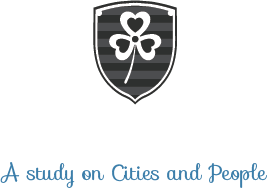Comparing the Public Life of Medium Sized Cities
How many is ‘many people’?
There are so many people here!” are a few words you have inevitably uttered or thought up when spending time outdoors in any city during the hot summer months. But have you ever considered how many people is ‘many people’? In order to address this seemingly simple but key question that is essential to understanding public life, I set out on a quest to count people spending time outdoors in 19 different European city centers of comparable size, observing a total of 112,622 people as part of this project. Subsequently, I compared the amount of people in each city center and was able to develop a framework to quantify the demographic make-up of public life. My data allows me to construct public life scales such that it represents a reference against which other cities of similar size can be compared.
We’ll find out the answer to the question above in three ways:
I. Are there many people on the main shopping street?
II. Are there many people spending time outside?
III. Are there many people on this spot, and how many spots are there?
These questions enable putting a number on expressions such as “too many” and “too few”.
The cities that were studied have a population ranging from 80,000 to 180,000 and are all located in central, western or northern Europe. There are about 200 such cities in this area, suggesting that the observations obtained in this project may be of great value to understanding the public life of about 8% of the northern, western, and central European population, which hosts a total of about 28 million people. One goal of addressing these questions is to help medium sized cities create better public spaces for everyone, by providing them with a empirical model of comparison to aid decision making concerning the development of livelier city centers.
I – Are there many people on the main shopping street?
By combining the data presented in my ‘how many people’ observations 1, 2 and 3 this page presents tools for predicting and comparing public life. The city of Nijmegen (170 600 population) will serve as our example of a medium city in this instance. There are about 200 other medium sized cities (80,000-180,000) in western, northern and central Europe. The further a city’s population is from this interval, the less reliable are the predictive and comparable value of my data.

Nijmegen has many shopping streets, but its main shopping street seem to be Molenstraat/Broerstraat, with various secondary shopping streets, such as Burchtstraat and Marikenstraat. Given my data for medium amount of people, Nijmegen should be able to sport between 2064-2559 (170 600 * 0,012 or 170 600 * 0,015) people walking up and down Molenstraat/Broerstraat during an hour during opening hours.


The prediction is that 1,12-1,51% of the total population of Nijmegen will walk on its main shopping street. If someone do count the amount of people and it shows that the value is smaller or bigger than our prediction, we are now able to say whether there are indeed many people or not. During closing hours the amount of people on the main shopping street drops naturally by about 65%. It’s interesting to note that women are always using the main shopping street more than men. For more data on main street demographics, see my observation.
II – Are there many people spending time outside?
For the second question we are concerned with how many people spend time outside doing stationary activities such as chatting, eating or relaxing outside. Stationary activity outside can occur in two places; public and private, and we’ll separate these two answers. Public places are any place you can spend time in without having to somehow pay for it, private places are almost exclusively outdoor seating connected to a restaurant. Again, using Nijmegen as our example and by using my data, we can predict that Nijmegen should be able to host 563-1040 people (170,600 * 0,0033 or 170,600 * 0,0061) in private places between 17:30-19:00 o’clock. For public places about 205-341 (170,600 * 0,0012 or 170,600 * 0,0020) people should spend time outside. In total, about 768-1381 people are predicted to be committed to some kind of stationary activity outside in Nijmegen. Again, if we were to go and count people spending time outside and it turns out the amount is lower or higher, we can determine whether it’s a low or high number of people.
Let’s say that we did count the number of people spending time outside in Nijmegen and the result was a total of 1364 people in private places. Then Nijmegen would have a public life value of 0,8%. Nijmegen would be placed in the High category of the scale in the image below, if we compare it to the time interval of 17:30-19:00.



To read more about how i define an active city center and more, see my observation.
III – Are there many people on this spot, and how many spots are there?
For the third question we’ll have to break down the data from the second question. The second question let us know how many people can be predicted to spend time outside, but we can also find out how many different spots there are for people to spend time in as well as finding out how active certain spots should be compared to others.
During my observations I’ve found that the amount of spots and their activity and spread are simply unpredictable due to the unique nature of every city’s layout. But we can still answer this question based on the average spots and activity from all 19 observed cities. First, this data is divided up between public places and private places, and furthermore divided up between three time intervals 15:00-16:30, 17:30-19:00 and 20:00-21:30. We’ll look at both public places and private places but only illustrate the time interval 17:30-19:00. By using standard deviation and observation I’ve concluded that a spot can have 6 types of activity intensity. How i define a spot and the 6 types of spot usage intensity are listed below.


Since we have predicted the amount of people spending time outside in Nijmegen, let’s use this city as an example again. Let’s take the average of our predictions, 802 ((563-1040)/2) people are spending time in private places, and 273 ((205-341)/2) people are spending time in public places.
In the image below I’ve applied my data to Nijmegen. Since I haven’t spent much time in Nijmegen, i have little clue to where people actually do spend time, but i can guess based on observations on google maps. In terms of private places, Nijmegen is predicted to have 1 solo spot, 9 tiny spots, 20 minor spots, 7 medium spots, 2 high spots and 1 very high spot. For public places Nijmegen is predicted to have 5 solo spots, 19 tiny spots, 5 minor spots, 8 medium spots, 1 high spot and 1 very high spot. Now we have an idea of what to at least expect in terms of people spending time outside in Nijmegen. If one would go out and count the amount of spots and their intensity, and come to the conclusion that the spots are both more numerous and their intensity even more active than predicted, then you can conclude that there are many people and many spots – in other words, a city that we might be able to learn from…

For even more data on where people spend time, see my observation here. All data was gathered on weekdays in July 2018-2019. If you have any questions, feel free to contact me at [email protected].


